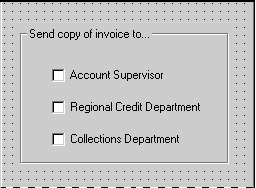
Consider an accounts receivable project, which contains one module and two forms. Each of the forms contains some controls. The structure of the project is shown in the following outline:
Project: AccountsReceivable
Module: MyMain
Form: Customer
Control: LabelCustomerName
Control: LabelOutstandingBalance
Control: TextCustomerName
Control: TextOutstandingBalance
Form: Invoice
Control: LabelCustomerName
Control: LabelInvoiceDate
Control: LabelPastDueCharges
Control: LabelCurrentCharges
Control: LabelTotalCharges
Control: TextCustomerName
Control: TextInvoiceDate
Control: TextPastDueCharges
Control: TextCurrentCharges
Control: TextTotalCharges
Control: FrameInvoiceCopies
Control: CheckboxAccountSupervisor
Control: CheckboxRegionalCreditDept
Control: CheckboxCollectionsDept
Control: CommandPrintInvoice
Control: CommandSaveWithoutPrint
Control: CommandCancelInvoice
The AccountsReceivable project contains two forms and a module at the first outline level below the project itself. The outline shows other kinds of component organized at the next level under the two forms, but there are none shown under the MyMain module. The outline reveals a characteristic of Visual Basic projects; forms may contain controls, but modules may not.
The Invoice form contains FrameInvoiceCopies, a control that contains three other controls. Here too, the example illustrates a characteristic of Visual Basic projects; a control can contain other controls. The following figure represents the FrameInvoiceCopies control:

There are four controls visible in the figure: one frame and three checkboxes. Speaking casually, we might say that the Invoice form contains all four controls. However, it is more precise to say that the Invoice form contains only the FrameInvoiceCopies control. Each checkbox is contained not within the Invoice form, but within the FrameInvoiceCopies control.
There is a similar outline that can be created for any Visual Basic project because every Visual Basic project has an inherent structure. It is this structure that the Repository Add-in for Visual Basic stores in the repository when it populates the MDO Model. And so it is this structure that the MDO Model must accommodate.